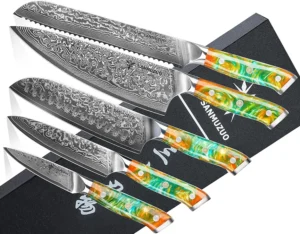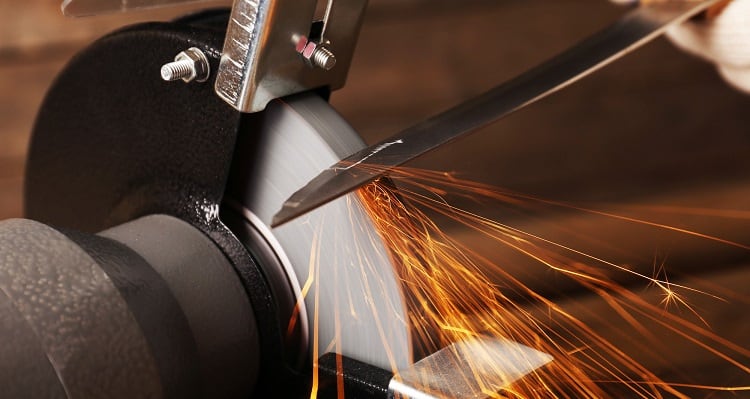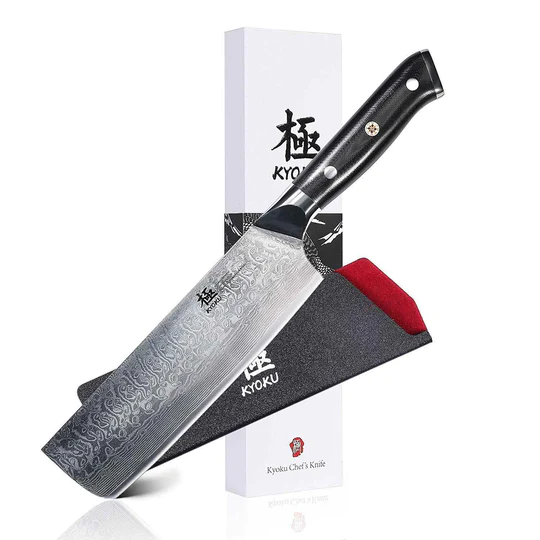


Choosing a chef knife sometimes feels like buying a car. All cars get you from A to B, but like chef knives, there are many models to choose from. This guide will help you choose the best chef knife for your kitchen and your budget.
When it comes to the knife material, one of the most important components obviously is the knife blade. The type of metal will impact the look and performance heavily.
I am a huge fan of Damascus Steel Knives. Damascus steel refers to the forging process of layering steel which results in a pattern well visible to the naked eye.
There is just something about the unique wavy patterns that make you feel like you are holding a work of art in your hand. But, apart from the aesthetics, there are also practical implications. Some argue that Damascus steel provides greater strength and cutting power without the risk of chipping or breaking the blade.
However, nowadays high-quality metals achieve very similar mechanical and structural characteristics. Therefore, the primary reason why there are so many Damascus steel chef knives are mostly for looks.
Stainless steel is an alloy of iron that tends to require less maintenance than carbon steel. It is highly resistant to corrosion but cannot take as sharp an edge as steel with a higher amount of carbon.
Carbon steel is considered a designer steel and is used by some of the top knife brands. High-carbon stainless steel offers better edge retention, sharpness, and resharpening ability than “normal” stainless steel. But, you have to make sure you take proper care of the knife and dry it thoroughly to prevent any discoloring or rust.

Blade length varies greatly depending on the purpose of your knife. Chef knives are typically 8 inches long. This provides a good balance between weight, cutting edge length and practicality. Anything bigger and you may struggle to cut efficiently.
In terms of weight, finding the right knife for you is more of a personal preference and how extensively you will use your knife. For shorter cooking preparations, a light knife may be more suitable to get the job done. If you are working at your cutting board for an extended period of time, a heavier knife will be the better tool for you.
Knives with lightweight blades are more flexible but have less chopping power. This is why paring or boning knives are some of the lightest knives on the market. They are meant for separation rather than chopping.
Heavy blade knives have greater chopping power. They are built for hacking through bone, but they are much more difficult to maneuver for more precise cuts.
The meat cleaver is a good example. This blade is built for hacking large pieces of meat. However, the cleaver is much more difficult to use for precise cuts.
You may have to work up to using heavier knives though. Some of these blades can weigh a pound or more. They can also be more dangerous since they’re so powerful, so make sure you’re using them safely and with caution.
Knives come in a variety of handle styles and materials that can be picked according to preference. While beginner knife users may appreciate the safety and security of a rubberized grip, others may benefit from nylon handles for reduced friction during use.
The handle material type should be based on what feels most comfortable for you while using your knife.
The blade edge varies greatly depending on the blade type. Pay attention to whether or not the knife is serrated, curved, or flat-edged. This will give you an idea of the knife’s intended purpose.

In a recent study, the knife injury rate in the USA is around 1.56 injuries for every 1000 people every year, with lacerations making up 94% of all injuries. This crucial number signifies that knife injuries are very common. To significantly reduce accidents, it is indeed very important to know the basics of knife safety.
Always use a good quality, well-made knife. While cheaper knives may be better for your budget, they will tend to be subject to breakage and even blade snapping, which can easily cause accidents.
Always keep hands away from the blade of your knife – the knife has a handle for a reason! For extra protection you can use cut-resistant gloves.
When washing dishes, never leave a knife in the sink or washing bowl when filled with soapy water. Unfortunately, placing hands into soapy water containing a knife is one of the most common causes of injury in the USA.
If you lose your grip on a knife, let it fall. Stand back and never, under any circumstances, try to catch it.
Never wave a knife around during use, for example when gesticulating or performing a demonstration. Should you need to use your hands, carefully place the knife down on a safe surface first.
Always use the right knife for the job and use your knife only for the intended purpose. Check out Knife Buzz’s Knife Safety Tips for more advice.

While having the proper accessories for your blades is more or less essential, it’s important that you also have a basic routine established to properly care for your blades. Follow these general guidelines to keep your blades in tip-top shape.
Most knives do well when stored in a cool, dry place. It’s important that you make sure your knife is in an area away from water since moisture can subject certain blades to rust and other water damage.
Moreover, knives are best kept isolated from one another. This is because too many knives in proximity can dull surrounding blades, not to mention make for a dangerous situation. Knives stored improperly in a crowded drawer can also be damaged by or damage other similarly kept kitchen tools.
Therefore, it is more or less essential that you keep your knives in appropriate sheaths, knife organizers, knife blocks, or on display with a magnetic strip or specially crafted shelf.

Regardless of the caliber of the blade, every knife needs a good sharpening every now and then. Sharpening your blades will ensure that your knife is as efficient as it can be. Moreover, using a dull knife is actually less safe than using a freshly sharpened blade. This is because you have to exert more energy while using dull blades which opens the window to more potential accidents.
You can use a sharpening rod or whetstone to sharpen your blade. There are also automated electric sharpeners that can make the process easier. However, it’s important to note that not all sharpeners can be used on any knife.
Your blade can become severely damaged by using improper sharpening techniques and surfaces. Make sure you are carefully sharpening according to your manufacturer’s instructions.
Moreover, if the process makes you too nervous all together, you can send your blades off carefully to a professional sharpening service to refresh your best blades. Some farmer’s markets offer this specialty service as well, so be sure to look out for potential service providers in your surrounding area.
The ridges on the back of a knife provide a better grip. This keeps your hand from slipping while you cut with the knife. This improved grip also allows you to exercise better control of the knife.
Most knives are not meant for cutting bone. Chef and kitchen knives are intended for cutting meat, vegetables, and fruits. If you want to cut through bone, look for a meat cleaver or butchers knife.
The best chef knife blades are made from high-carbon stainless steel or carbon steel. High-carbon stainless steel balances durability and rust resistance.
Carbon steel offers superior sharpness and ease of sharpening. These blades require more maintenance to prevent rust.
A Dimple blade design reduces friction and allows cut food to fall away from the blade. This feature is useful when cutting starchy foods.
A hollow edge is often found in professional chefs knives. The small indentations along the blade reduces friction and prevents food from sticking when cut.
So there you have it, an easy to follow guide on how to pick the perfect chef knife. Of course, everyone has their own taste and preferences. But, you really can’t go wrong with an 8-inch chef knife that not only feels great but also looks great.

Knife Buzz offers independent product reviews on a wide range of knives used in the kitchen, home, and outdoors. We make it easy for you to find the right knife at the best price.